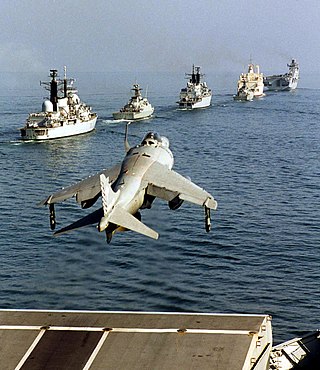| NBMR-3 | |
|---|---|
 Conceptual model of the VFW VAK 191B V/STOL fighter-bomber aircraft | |
| General information | |
| Project for | Development of VTOL military aircraft |
| Issued by | NATO |
| Prototypes | Dassault Mirage IIIV EWR VJ 101 VFW VAK 191B |
| History | |
| Initiated | 1961 |
| Concluded | 1967 |
NBMR-3 or NATO Basic Military Requirement 3 was a document produced by a North Atlantic Treaty Organisation (NATO) committee in the early 1960s detailing the specification of future combat aircraft designs. The requirement was for aircraft in two performance groups, supersonic fighter aircraft (NBMR-3a) and subsonic fighter-bomber aircraft (NBMR-3b). Both requirements specifically stated the need for V/STOL performance as the contemporary fear was that airfields could be overrun or disabled through Eastern Bloc hostile actions and that dispersed operating bases would be needed. Germany was planning replacements for the Fiat G.91 and Lockheed F-104G Starfighter using the new aircraft types.
Contents
- NBMR-3a
- Minimum requirements
- Aircraft designs submitted
- NBMR-3b
- Minimum requirements 2
- Aircraft designs submitted 2
- VAK designs
- ZELL/SATS
- NBMR-4
- Aircraft designs submitted (NBMR-4)
- Aircraft designs submitted (NBMR-22)
- Aero engine development
- End of programmes
- See also
- References
Aircraft manufacturing companies of European countries were invited to submit designs, from a short-list of 10 supersonic fighter designs two were chosen as the joint winners, the Hawker Siddeley P.1154 and Dassault Mirage IIIV. Disagreement over the balance between best performance aircraft and one which would benefit the aircraft industry more meant that neither type entered service.
Subsonic fighter-bomber designs were also submitted to fulfil the second part of the requirement, of 11 designs four were short-listed with the VFW VAK 191B being declared the winner. This aircraft was built and flown but did not enter service.
A contemporary alternative to new aircraft type procurement was the novel idea of rocket launching existing fighter aircraft types from ramps and recovering the aircraft on short strips using arrestor gear. A related requirement, NBMR-4, detailed specifications for transport aircraft with similar performance to support the fighter and fighter-bomber aircraft at remote sites. The Fiat G.222 and Dornier Do 31 were the only designs to fly from a revised requirement (NBMR-22), the Dornier being used for test purposes only.
Engine development for new powerplants ran alongside the aircraft projects. The requirements were withdrawn in 1967, aircraft prototypes that had been built were used for experimental purposes until they were retired in the early 1970s. Examples of aircraft types involved in the programme have been preserved and are on display in aviation museums.















